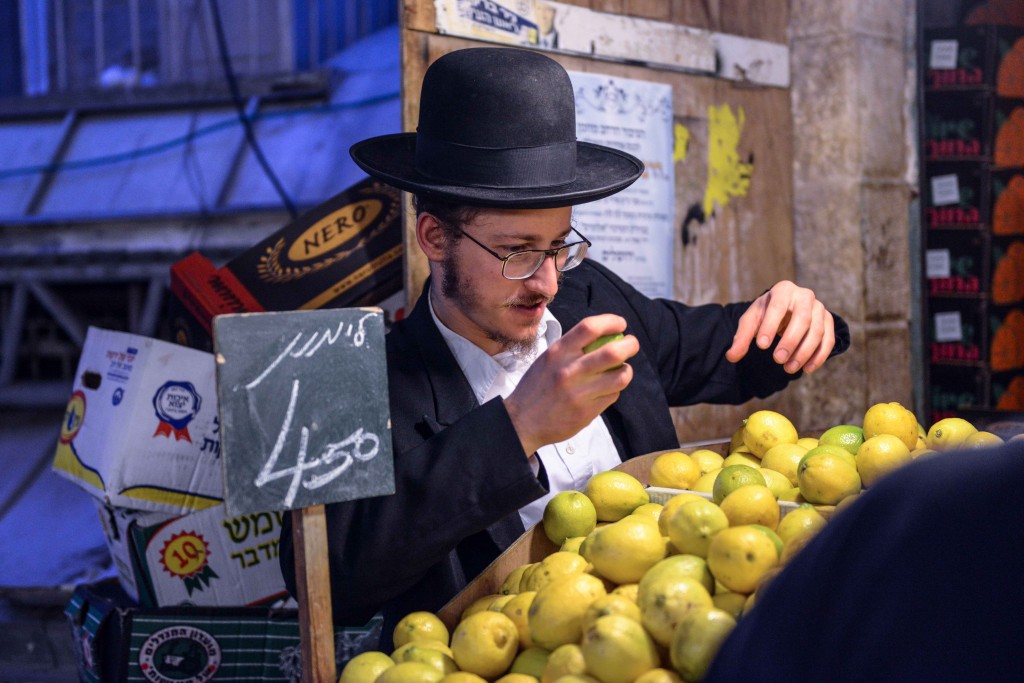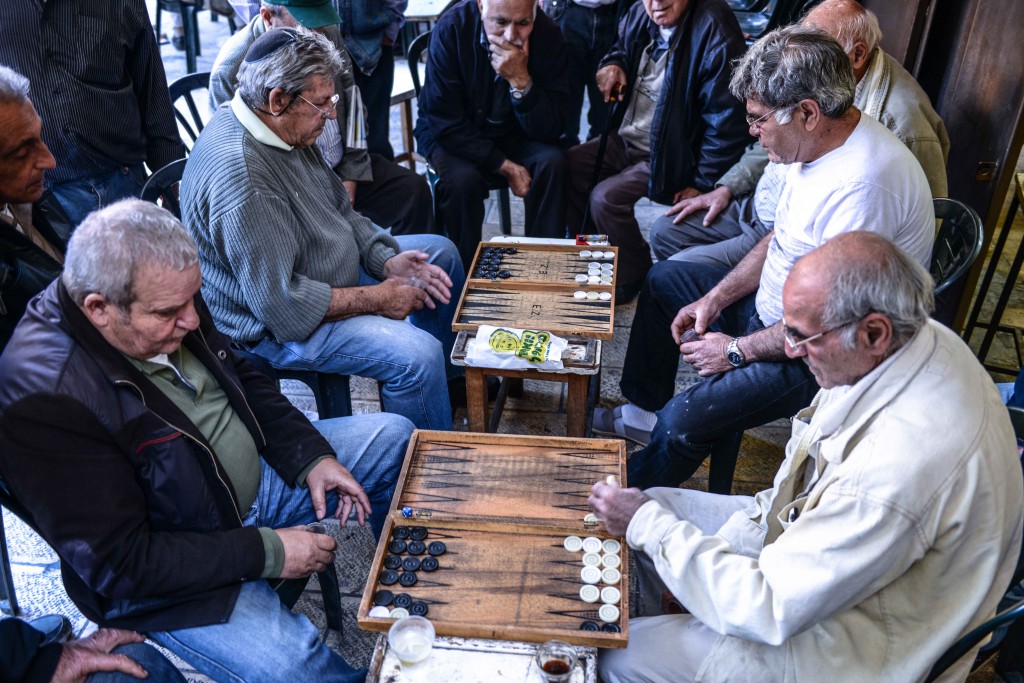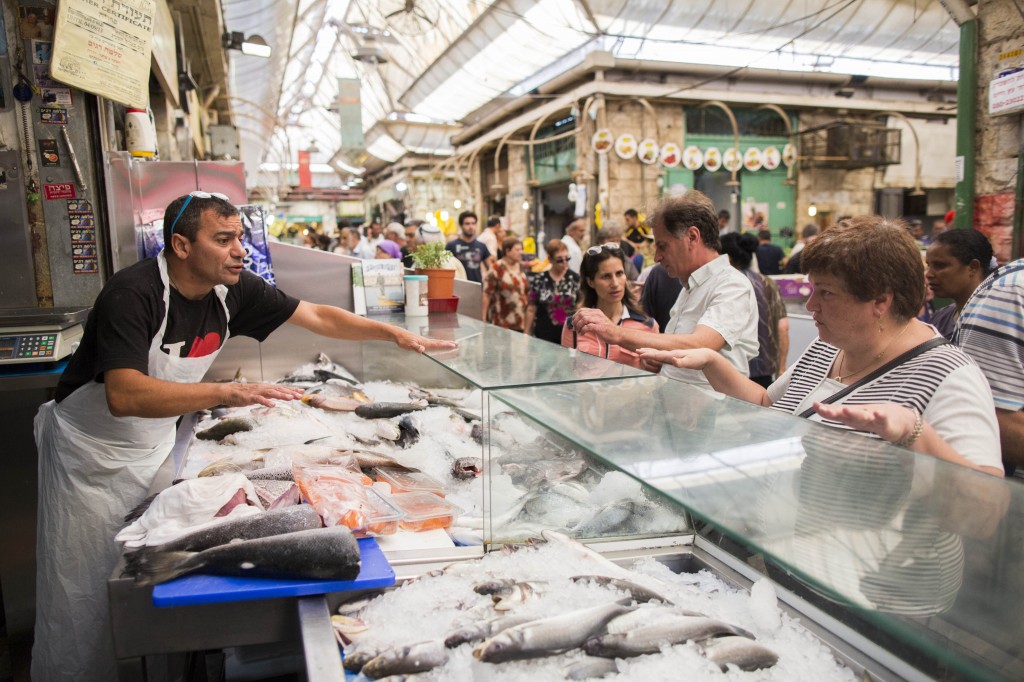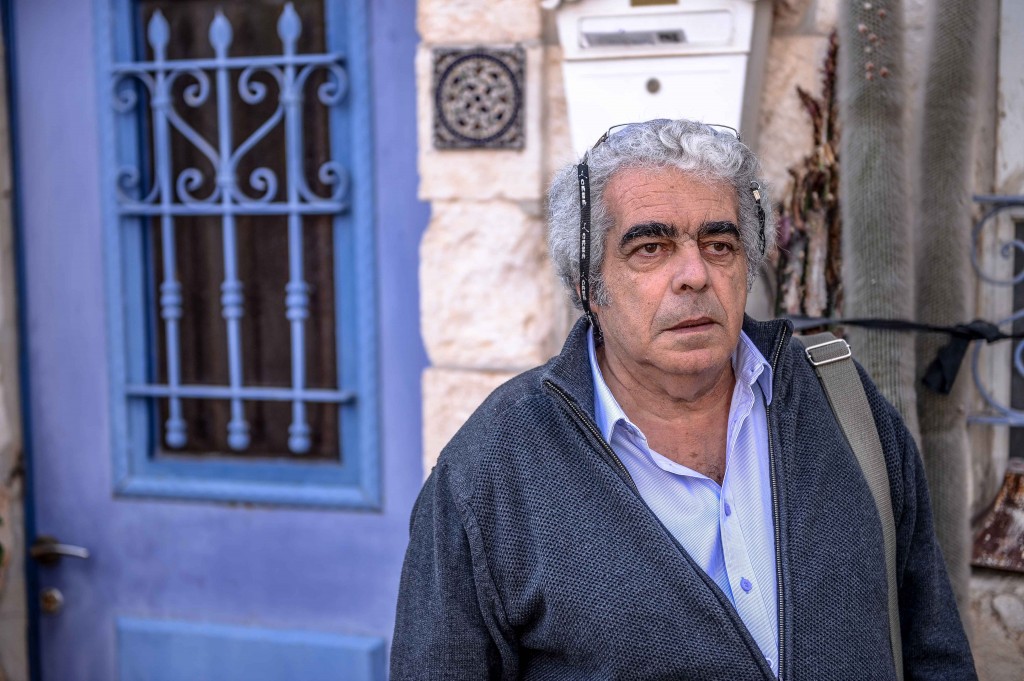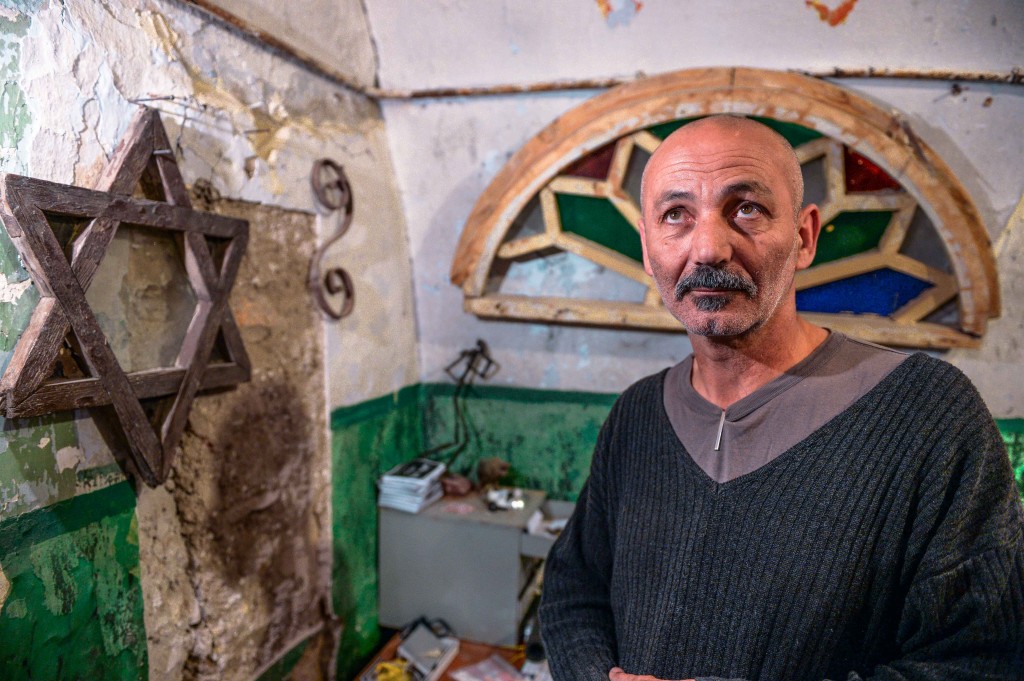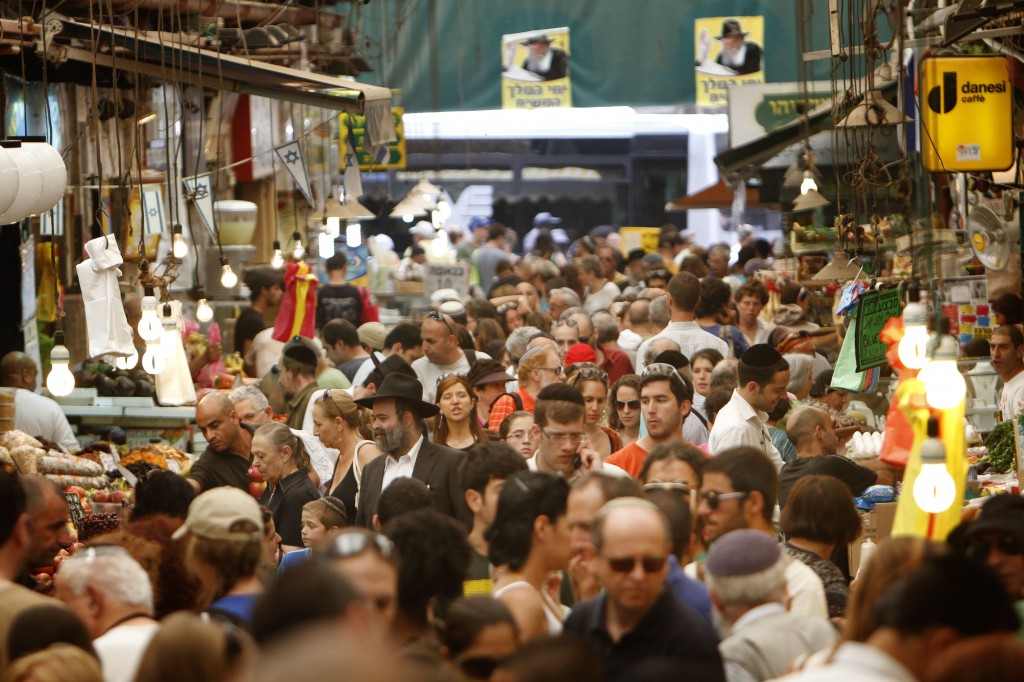A decade and a half ago, Jerusalem’s outdoor market was the target of multiple terror attacks. Since then, it has grown into a hub of culture, infrastructural upgrades and edgy commerce.
“Just imagine,” Itay Mautner, creative director of the Jerusalem Season of Culture, says to me, “how many lips around the world mumble a few times a day during prayer, the word ‘Jerusalem.’”
We are sitting at the bar of Machneyuda, a famed restaurant situated in the Machane Yehuda market in Jerusalem, facing the open kitchen where chef and owner Assaf Granit is placing before us an array of dishes: Fried dumplings, a twist on traditional Jewish kreplach, which is usually served steamed; an assortment of raw fish with fresh strawberry and chili paste; eggplant-cream-filled steamed dumplings in milk foam; grilled squid with root-vegetables; roasted lamb ribs on a rich bed of ragu. Machneyuda is a loud, colorful restaurant, and it’s always packed. An upscale restaurant in downtown Jerusalem, serving non-kosher cuisine in a casual atmosphere soaked in alcohol, it was an abnormality in the subdued Jerusalem landscape of the time; and when it opened its doors in 2009, it made an immediate impact. It was also a huge gamble, driven by Granit’s vision of Machane Yehuda as a hip culinary spot. And it worked. Big time. Today, the 150-year-old market is a prime tourist attraction, a must-see on every tour of Jerusalem. It’s the perfect place for Mautner to hold court. His organization, Jerusalem Season of Culture, is a privately funded group that produces a cultural festival every summer in the holy city. Dozens of events take place across Jerusalem day and night; events designed to tell the story of a city that, in many ways, lost its sparkle in recent decades. The group has been operating for the last five years, and one of its first focal points was Machane Yehuda. In 2009, 2010, and 2011, the market was ablaze with cultural events. Live music shows were held between vegetable stands, performance-art acts filled the balconies above the shops, and the crowds flooded in. Celebrations of such size were a rare sight in Jerusalem until then.
But why Machane Yehuda? “Five years ago Jerusalem was irrelevant to the non-religious crowd,” Mautner says.
We wanted to turn this notion upside-down, and our first task was to recognize specific places and trends that are unique to Jerusalem and amplify them through art. We felt that the Machane Yehuda market was the perfect place to go at it. Our aim was to share the unique and complex narrative of Jerusalem, and Machane Yehuda was very identifiable in our minds with the city itself. We looked at the market as a space that invites local artists to create and perform; to create using the market as their canvas. We planned the whole thing with the merchants themselves. It was crucial for us that they were an integral part of the celebrations, since the market is their place above all.
The opening of the Machneyuda restaurant and the success of the Jerusalem Season of Culture were milestones in the transformation of Machane Yehuda into a national darling. To many Israelis, Machneyuda is the symbol of the new Machane Yehuda. It is Machneyuda that has succeeded in drawing the Tel Aviv crowd out of its gated culinary community, not an easy feat to accomplish. It has been hailed for its vision and the guts to identify itself with a not-so-popular market. But what needs to be remembered is that when Machneyuda came to be, the Machane Yehuda market was already a renovated, vital, and diverse place, housing quite a few restaurants and cafes. Granit’s bet was a turning point, no doubt, but the foundations were already laid.
The Machane Yehuda market holds a unique historical, geographic, and social place in Jerusalem. It stands at the crossroads of Orthodox Jerusalem, secular Jerusalem, and Arab Jerusalem. All these different Jerusalemites, who rarely mix elsewhere, meet in the streets and alleys of Machane Yehuda on both sides of the stalls. Everyone sells and everyone buys. It is a market after all, and price and quality call the shots. It is a meeting point by default, and always has been.
It was originally established in the late 19th century under Ottoman rule, partly out of necessity and partly out of communal, bicultural laziness. Both the Jewish population of the nearby Nachlaot neighborhood and the Arab population of the surrounding villages were fed up with the long walk to the Old City market. So they set up a few sheds, had local farmers bring their crops, and a market was born. But it is the 150-year-old mix of people that makes Machane Yehuda so valuable to Jerusalem; the coming together of a population divided by centuries of conflict and mistrust. Walking the streets of the sprawling market is a vivid experience. Between the fruit and vegetable stands, the butchers and spice merchants, one can find numerous eateries and cafes, clothing and jewelry shops. To the newcomer, they are all nestled naturally amongst each other, creating a vibrant, modern, and very attractive city market. But for those familiar with the Machane Yehuda of three decades ago, this is nothing less than a miracle. Going back to the ’80s and early ’90s, a very different market emerges. During those years, Machane Yehuda was mostly known for its poor sanitation and deteriorating infrastructure, its chaos and hoards of illegal stalls, and its unmistakable flair for behind-the-scenes criminal activity. To say the least, it presented a challenging experience for Jerusalemites. Sewage ran through the unpaved streets and alleys, unpleasant smells filled the air, and due to a lack of roofing, shoppers and goods alike were soaked by the frequent winter rains.
Surprisingly enough, the market held its ground. But then, as Yoram Amir, an activist, artist, and self-described anarchist, puts it,
Three simultaneous elements brought the market to its knees: One was the continuous neglect by the city authorities of the sanitation of the market; the second was the emergence of the big food chains setting up mega-supermarkets in the satellite residential neighborhoods of Jerusalem; and, lastly, a devastating succession of terrorist suicide attacks in the market. A total systems collapse.
The most notorious suicide attack on Machane Yehuda took place on July 30, 1997. At 1:15pm, two Hamas terrorists dressed as Orthodox Jews detonated themselves in the middle of the crowded market. The devastation was immense. Sixteen people were killed and 178 injured; among them tourists, teenagers, and Israeli Arabs. The effect on the market, magnified by more attacks to come, was no less devastating. It was summarily emptied of its most vital component—shoppers. Jerusalemites avoided the market, as they did the city center in general. They were scared, and rightly so. The situation almost killed the Machane Yehuda. It was on the verge of shutting down and city authorities were less than inclined to put in the effort and resources necessary to resurrect it. But then came the Cinderella story of Cafe Mizrachi, which gave Machane Yehuda a much-needed shot of relevance. Eli Mizrachi’s family has owned a stand in Machane Yehuda for decades, selling roasted nuts and seeds, an immensely popular Israeli snack called pitzuchim. In the late ‘90s, Mizrachi watched helplessly as the market seemed to be slowly but surely dying. But he had an idea. Inspired by what he’d seen abroad, he wanted to open a cafe in the center of the market. His family was vehemently against it. The other merchants simply thought he was insane. Who would come to drink espresso and eat brioche in Machane Yehuda? But Mizrachi realized that this was a make-or-break moment for Machane Yehuda. Feeling he had nothing to lose, he converted the family storage space adjacent to their stand into a coffee shop he called Café Mizrachi.
Mizrachi remembers that, in the early days, when merchants wanted a macchiato they would ask for “that Japanese coffee.” Sitting in a narrow alley among stands selling spices and meat, the elegant cafe was clearly out of place. So out of place it almost had to work. And it did. Cafe Mizrachi is now etched into the unwritten history of Machane Yehuda as the market’s breakthrough moment. And the fact that it was conceived and built by one of their own is a point of pride for the market’s merchants. During many conversations, not one failed to mention Mizrachi’s transformative idea. Eli Mizrachi and Assaf Granit are the two stars of Machane Yehuda’s modern transformation: One ignited the revolution and the other blasted it to the stars. And they both shared a vision; a vision of a different market, one in which the ancient concept of an open-air food bazaar is intertwined with a modern-day culinary hot spot, and the two sides feed off each other. Machneyuda is outspokenly proud of the fact that it gets all its supplies from nearby stands and shops, as does Cafe Mizrachi. Both, by their own account, enjoy the flow of customers generated by the two-dozen restaurants and cafes that surround them. But as with Granit, when Mizrachi opened his iconic cafe, the alley in which it was located was nicely paved, there was a transparent roof above letting the sunlight in and keeping the rain out, and a newly-installed sewer system and renovated infrastructure were already in place. The market was indeed losing its relevancy and suicide attacks were systematically emptying it; but it was also in the midst of a massive preservation and renovation effort, and was already looking better than it ever had in the past. To a great extent, this was due to one unsung hero.
Uri Amedi, a native Jerusalemite and community organizer of 40 years, describes Machane Yehuda in the early ’80s as “the backyard of Israel, the garbage can of Jerusalem.” Like many, Amedi sees the Six-Day War of 1967, in which the Old City of Jerusalem returned to Jewish hands for the first time in millennia, as the major turning point in the modern history of West Jerusalem. Jerusalem experienced both exponential population growth—200,000 pre-war to 800,000 post-war—and a destructive decline of the city center.
There was complete social disintegration. The educated and affluent population left the city and moved to the more modern, spacious residential neighborhoods on the outskirts of Jerusalem. As in every other walk of life, there is never a vacuum. One thing gets out, another thing gets in. In Jerusalem’s case, what came into the city center was crime, drugs, and rats. This was followed by an economic and cultural collapse when both the Hebrew University and Bezalel Academy of Arts fled to Mount Scopus. Add comprehensive neglect to that and you’ve got a bankrupt city center.
Over the next decade-and-a-half, the situation only got worse, with Machane Yehuda becoming Jerusalem’s rotten knight in filthy armor. All of the city’s problems seemed to drain into the market, which reached its nadir in the early ’80s. When Meir Kahane, leader of the extreme Right-wing Kach party, won a Knesset seat in the 1984 elections, where did he take his victory lap? In Machane Yehuda. “Why there?” Amedi asks. “Because everything was rotten there, everyone was desperate and angry. It was fertile ground to recruit soldiers for his dark fantasies.” Amedi grew up in downtown Jerusalem, and he realized that, in order to heal Jerusalem, he had to start with its most diseased limb—the Machane Yehuda market. He asked the municipality to appoint him the market’s community organizer. No one on the city council really understood what the young man wanted to do there, but he insisted. He managed to get a meeting with then-mayor Teddy Kollek, and explained his 30-year plan for the transformation of Machane Yehuda. Kollek agreed. Shortly after, Amedi walked into Machane Yehuda and stayed there for the next 30 years. When I interviewed him, he showed me the hand-written notes he used at the fateful meeting. It is astonishing to see how his vision for the market has been realized down to the tiniest detail. One of the most remarkable things about Amedi’s journey was his very first move, taken after a full year of “meetings on flipped crates with all the merchants.” Gaining the trust and cooperation of the merchants is a task that not many people would be able to accomplish, not then and not now; so the first issue that Amedi decided to tackle in the crumbling, neglected, crime-infested market of the early ’80s was the merchants’ self-image. The only way to cure the market, he felt, was by first curing the merchants themselves. So he got them to chip in and throw a Purim party for a group of soldiers at an army base. “We left the market as bastyonerim [slang for “stall owners”] and returned as a group of people that did something valuable,” he says.
That was his in. After that, the merchants accepted Amedi as one of their own, paving the way for his next move—renovating the market itself. It took him another three years to organize elections for a managing director and secure funding from the city council. He got the merchants involved in planning the renovation, holding flipped-crates meetings with each one in order to hear their needs and wants. Then he reached another remarkable conclusion: Every merchant would have to shoulder part of the cost of renovation; not only of his own stall or shop, but also the public space surrounding it. It is difficult to fathom the guts and will required to tell the merchants of Machane Yehuda, a group not known for its calm and agreeable nature, that they would need to (a) shut down their businesses for three to four months, and (b) help pay for it. It was nothing less than outrageous. And, somehow, it worked. Amedi got every single merchant and stall owner to agree. The renovation began in 1984 and the last section to be restored, the Georgian Market, was finished in 2011. Exactly a century ago, the newly clean and spacious site of the Georgian Market was the Casino de Paris Hotel, a cool and rowdy hangout for wealthy Arabs, British officers, and friendly Jewish gals. Yes, even Machane Yehuda got its dose of the Roaring ‘20s. The hotel closed its doors in 1936 when the Arab Revolt broke out. During the 2011 renovation of the Georgian Market, Eli Mizrachi took it upon himself to meticulously restore the hotel’s bar and reopened it under the same name.
“What I’m thinking about,” says Yoram Amir, the activist artist, “is the 70-year-old woman who did her grocery shopping at the market all her life. Is the market, in its current incarnation, still providing her what she needs? Is it still a place she can buy food?” Amir has the demeanor of a Bill Murray character in a Wes Anderson film. His voice is round and warm, his attitude nonchalant, his eyes have a constant amused jitter. He is an ex-merchant himself, and once had a photo shop in Machane Yehuda.
Back in 1999, Jerusalem’s sanitation workers went on strike. For the five days before Rosh Hashanah, garbage was not collected. Amir remembers his frustration watching it pile up in front of his shop and throughout the market. His outlet was an artistic one. “I made a garbage film,” he says. “But then someone told me, ‘You care? You want to make a change? Then you need to be where you can make a difference.’ So I decided to run for managing director. I won, and in 2000 took the helm of the market. But after a year I was burned out, so I quit.” Since then, Amir has used his art to protest what he sees as the destruction of the city he loves. He made a name for himself in 2007, when he climbed the still-unfinished Bridge of Strings at the entrance to Jerusalem and threatened to jump. It was an act of protest against the “ugliness of the bridge.” He never meant to jump, he says, but his act speaks volumes about the intensity with which he operates.
“So going back to that 70-year-old woman. She walks around in a market packed with tourists, no one is even carrying shopping bags; and she doesn’t understand what happened to her market. What about her?” Amir makes a valid point. Machane Yehuda is now a hot local and foreign tourist destination, and a very popular hangout for Jerusalemites. But has it lost its true nature as a food bazaar? In 2000 there were 58 stands and shops selling tomatoes. Today, there are 14. As the market has evolved and reinvented itself, many of the fruit and vegetable shops have been replaced with restaurants and cafes. The market is slowly being lured into putting aside its real purpose and becoming something else. It is hard to blame the merchants themselves for this, of course. In the current situation, what is more profitable to sell to the thousands of tourists who walk the market every day—a pound of tomatoes, or ice cream and espresso? “The market,” Amir continues,
used to cater to all segments of the population. In the mornings the merchandise went for high prices. The rich came to do their shopping. At noon, middle of the day, when prices dropped a bit, downtown residents and blue-collar folks arrived at the market. End of the day, the late afternoon hours, is when the poor came to the market, since prices dropped significantly because the merchants needed to get rid of their stock. A market that operates with three different price ranges through a single day is important to a city. It serves its residents in a meaningful way. This is not the case now. Ice cream and espresso prices don’t drop, not in the middle of a day and not at the end.
Surprisingly or not, Amedi, architect of the new Machane Yehuda, agrees.
One more Aroma [a Starbuck’s-style coffee chain] and the market is finished. We need to be very attentive to the entire scope of processes that take place. A market cannot be stuck in nostalgia; it needs to be open to the future; but at the same time respect its past. It’s an extremely difficult balance to achieve—how to preserve important elements of the market while not rejecting progress.
Will this trend continue? The replacement of fruit and vegetable shops with eateries and bars? In five or ten years, will Machane Yehuda be just another tourist trap? Amedi smiles. “If Machane Yehuda were not a market,” he says, “it would lose its allure as a hangout place. Folks wouldn’t find a reason to go there anymore.” It’s a fascinating observation. The market, it seems, has gone through a complete inversion of its purpose. The entire idea behind renovating the market and transforming it into a hot destination was to support the fruit and vegetable stands by attracting bigger crowds. But now, those stands actually support the cafes and shops by providing them with an “authentic” background. Both Amir and Amedi feel the stakes are too high to leave matters to chance, to let Machane Yehuda continue to float aimlessly down its current path. And each of them separately arrived at the same solution: Offer incentives to the stall-owners who sell basic foodstuffs—fruits and vegetables, meat and fish, spices and roasted nuts, etc. “Take the pumpkin merchant,” Amir explains.
His father sold pumpkins. His grandfather sold pumpkins. But he says, “I don’t want to sell pumpkins, I want to open an espresso bar.” You can’t force him to sell pumpkins, can you? But if the city offers him a discount in taxes and regulates his rent so long as he keeps selling pumpkins, he might reconsider. It might convince him to continue selling pumpkins, to continue his family tradition, and to preserve the market as a place to shop for food. That what a real market is—a place to buy food to cook at home.
“The elderly woman with the shopping bags doesn’t have the buying power to continue and sustain the market,” says Amedi.
Her buying power isn’t strong enough to support the 500 businesses that operate there. We must search and find the right mix. If the right mix of food stalls versus leisure isn’t achieved, the market won’t survive. Another mix we must consider is the shoppers themselves. Who comes to shop at the market? Everyone. Secular and Orthodox, Jews and Arabs. There is no other communal space in Israel where you will find a crowd as mixed as in Machane Yehuda. And if you understand the importance of this human intersection, informal human intersection, but an intersection that holds the future of Israeli society, then we must make sure that this meeting point is worthy of everyone who comes.
Machane Yehuda has transformed into a much larger, more significant entity than it was ever intended to be. The boundless love that has been poured into it over the last three decades by groups like Jerusalem Season of Culture, businesses like Machneyuda and Cafe Mizrachi, and individuals like Amedi and Amir, has elevated Machane Yehuda from a market to a symbol of Jerusalem and even Israeli society as a whole.
“Jerusalem has its holiness and its soul,” says Amedi. “Its holiness belongs to all people, all religions. Its soul is Machane Yehuda. Since Jerusalem belongs to all people and all religions, if you hurt its soul, the market, without realizing what you are doing, you are hurting the soul of a massive collective of people.” Amir tells the same story in different words:
Everywhere you raise your head in Jerusalem you see cranes. They want to develop the city. Develop, develop, develop. But what about some thought, some attention, some care for preservation? It doesn’t make sense to be uncivilized toward your own city. And Jerusalem is much more than the place where Jerusalemites live. It belongs to the entire nation. We must be more civilized with Jerusalem. We should use the beauty and extraordinariness of Jerusalem to change ourselves, the way we behave as people. To let the power and history of the city influence us and not the other way around.
The most beautiful and telling moment at Machane Yehuda comes every Friday, just before Shabbat commences. Orthodox men, already dressed in their finest clothes, descend on the market from the adjacent neighborhoods. With Shofars in their hands, they urge merchants and shoppers alike to conclude their business, go home, and prepare for Shabbat. They blow the shofar while reciting, “Turn off the weights! Turn off the weights!” a reference to the long-outdated method of weighing fruits and vegetables on mechanical scales. At this moment, past and present lose their relevance, people from all walks of life merge, and one realizes that only Machane Yehuda can still provide a place where the entire city becomes one.
![]()
Banner Photo: Aviram Valdman / The Tower






